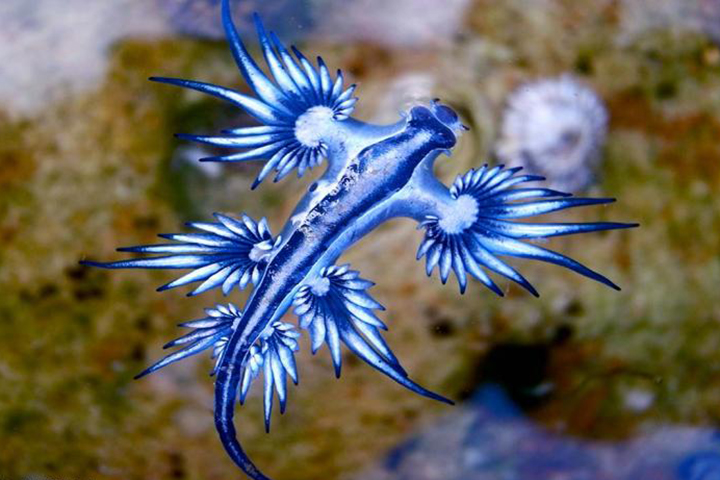Dragons exist — though they’re a bit smaller than you might have imagined.

A stunningly beautiful and bizarre little sea creature has Texas wildlife experts on edge after several beach-goers reported finding so-called “blue dragons” washed up at the Padre Island National Seashore in recent days.
The extremely rare little creatures look like electric-blue dragons “soaring” through the water. However, they’re actually a curious form of sea slug known as Glaucus atlanticus that swims upside down to show off its colours. And while they don’t breathe fire, they do pack a nasty sting that they borrow from their favourite food.
The 3 cm long creatures prey on the Portuguese man-o-war, a jellyfish-like organism with painful stingers. The blue dragon basically kills man-o-wars and steals their stinging toxins, then re-purposes those toxins into a defensive weapon.
That means it can surprise a curious human with a powerfully jellyfish-like sting if it’s disturbed.
Hunter Lane, seven years old, was among the first beach-goers to find the blue dragons on Padre Island earlier this month, according to the park. The boy spotted several of them on the shore and collected one in a bucket to show his dad.
“Hunter loves sea creatures and thought he had found a blue button jellyfish,” Trey Lane, Hunter’s dad, told CNN. “After they picked it up in a beach toy he proclaimed to me that he had discovered a new species!”

Get breaking National news
Trey Lane says he’s been visiting the park for 30 years and he’s never seen a blue dragon there before.
Hunter’s mother, Leah Lane, says they found four more blue dragons after the initial discovery.
“One washed up right next to my foot at some point. Luckily, I saw him and didn’t step on it,” she told local news station KSAT.
She added that Hunter “really wanted to touch it” because it looked soft and squishy. However, she says the boy had second thoughts when he considered the blue dragon’s bright colour, which he compared to a poison dart frog.
“He is kind of brightly coloured, which is a warning,” the boy said, according to Leah Lane. “Smart kid,” she added.
The Lanes presented the creature to park staff, who told them that they were very lucky they hadn’t touched the creature directly.
The park issued a warning on its Facebook page last week after several more blue dragon sightings on the shore.
“Don’t let their size fool you,” the park wrote. “They have a defence worthy of the name dragon.”
The post explains that blue dragons move the man-o-war stingers onto their “fingers,” which allows them to deliver a sting “more painful than a man-o-wars.”
“If you see a dragon in the park, be amazed as they are a rare find, but also keep your distance,” the park said.
Several people have posted photos of the sea slugs, which are also known as blue angels, since they started washing up in Texas.
No injuries have been reported to date.
Blue dragons float with their brightly-coloured bellies facing upward so they blend in with the water, according to Oceana, a conservation non-profit dedicated to ocean research. The sea slugs look like chunky bears with big noses when they’re out of water.
Researchers don’t know exactly how widespread the blue dragons are, but they are known to wash ashore in “blue fleets” from time to time. These blue fleets can be a painful, though not usually deadly, surprise for beach-goers.
It’s unclear why they’re washing up in Texas right now.
Perhaps Mother Nature is trying to give humans another reason to stay indoors?
- U.S. Election 2024: Questions arise over groups door-knocking for Donald Trump
- Hezbollah launches overnight rocket barrage in response to Israeli attacks
- Harris pushes for second debate while Trump declines because early voting has started
- FBI agents board vessel managed by company whose other cargo ship collapsed Baltimore bridge










Comments